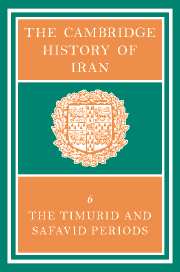Book contents
- Frontmatter
- 1 THE JALAYIRIDS, MUZAFFARIDS AND SARBADĀRS
- 2 TĪMŪR IN IRAN
- 3 THE SUCCESSORS OF TĪMŪR
- 4 THE TÜRKMEN DYNASTIES
- 5 THE SAFAVID PERIOD
- 6 THE SAFAVID ADMINISTRATIVE SYSTEM
- 7 EUROPEAN CONTACTS WITH PERSIA, 1350–1736
- 8 TRADE FROM THE MID-14TH CENTURY TO THE END OF THE SAFAVID PERIOD
- 9 SOCIAL AND INTERNAL ECONOMIC AFFAIRS
- 10 THE EXACT SCIENCES IN TIMURID IRAN
- 11 PERSIAN SCIENCE IN SAFAVID TIMES
- 12 RELIGION IN THE TIMURID AND SAFAVID PERIODS
- 13 SPIRITUAL MOVEMENTS, PHILOSOPHY AND THEOLOGY IN THE SAFAVID PERIOD
- 14 CARPETS AND TEXTILES
- 15 (a) TIMURID ARCHITECTURE
- (b) SAFAVID ARCHITECTURE
- 16 (a) THE PICTORIAL ARTS IN THE TIMURID PERIOD
- (b) THE ARTS IN THE SAFAVID PERIOD
- 17 (a) PERSIAN LITERATURE IN THE TIMURID AND TÜRKMEN PERIODS (782–907/1380–1501)
- (b) HĀFIZ AND HIS CONTEMPORARIES
- (c) PERSIAN LITERATURE IN THE SAFAVID PERIOD
- 18 PERSIAN POETRY IN THE TIMURID AND SAFAVID PERIODS
- Bibliographies
- Plate section
- Plate section
- Plate section
- Maps
- References
2 - TĪMŪR IN IRAN
Published online by Cambridge University Press: 28 March 2008
- Frontmatter
- 1 THE JALAYIRIDS, MUZAFFARIDS AND SARBADĀRS
- 2 TĪMŪR IN IRAN
- 3 THE SUCCESSORS OF TĪMŪR
- 4 THE TÜRKMEN DYNASTIES
- 5 THE SAFAVID PERIOD
- 6 THE SAFAVID ADMINISTRATIVE SYSTEM
- 7 EUROPEAN CONTACTS WITH PERSIA, 1350–1736
- 8 TRADE FROM THE MID-14TH CENTURY TO THE END OF THE SAFAVID PERIOD
- 9 SOCIAL AND INTERNAL ECONOMIC AFFAIRS
- 10 THE EXACT SCIENCES IN TIMURID IRAN
- 11 PERSIAN SCIENCE IN SAFAVID TIMES
- 12 RELIGION IN THE TIMURID AND SAFAVID PERIODS
- 13 SPIRITUAL MOVEMENTS, PHILOSOPHY AND THEOLOGY IN THE SAFAVID PERIOD
- 14 CARPETS AND TEXTILES
- 15 (a) TIMURID ARCHITECTURE
- (b) SAFAVID ARCHITECTURE
- 16 (a) THE PICTORIAL ARTS IN THE TIMURID PERIOD
- (b) THE ARTS IN THE SAFAVID PERIOD
- 17 (a) PERSIAN LITERATURE IN THE TIMURID AND TÜRKMEN PERIODS (782–907/1380–1501)
- (b) HĀFIZ AND HIS CONTEMPORARIES
- (c) PERSIAN LITERATURE IN THE SAFAVID PERIOD
- 18 PERSIAN POETRY IN THE TIMURID AND SAFAVID PERIODS
- Bibliographies
- Plate section
- Plate section
- Plate section
- Maps
- References
Summary
Tīmūr's advances from Transoxiana into the Near East radically transformed conditions in Iran. The resulting changes were not confined to political affairs or to the structure of the state but also affected to a considerable degree the ethnic composition of Persia, the economic and social situation in the country and its cultural development.
In the decades following the demise of the Īl-Khān Abū Sa'īd the state of Iran was fragmented and there was widespread evidence of the collapse of national power. In itself, this might well have aroused the expansionist appetites of neighbouring states much earlier, but with the exception of the Golden Horde they simply lacked the military strength to take advantage of the situation. The Ottoman empire, as yet in its early stages, was just one of countless Anatolian principalities and constituted even less of a threat to Iran than any of the Türkmen tribal groups, such as the Qarā Quyūnlū, that were still struggling to obtain a political status. Nor is there any record of military advances by Egypt into Iran. The vast distances and the almost insurmountable geographical barriers involved make it unlikely that even the Mamlūk sultans contemplated such invasion plans, and certainly any hopes the Muzaffarid Shāh-i Shujā' may have entertained when he granted recognition to the token caliph al-Mutawakkil 'alā'llāh Abū 'Abd-Allāh Muhammad of Cairo were to remain unfulfilled. The situation was quite different, however, as far as the Golden Horde was concerned. At the court of Sarāī a keen interest was shown in events in Persia, and the ruling khans of the period were greatly attracted by the idea of gaining influence there.
- Type
- Chapter
- Information
- The Cambridge History of Iran , pp. 42 - 97Publisher: Cambridge University PressPrint publication year: 1986
References
- 7
- Cited by

